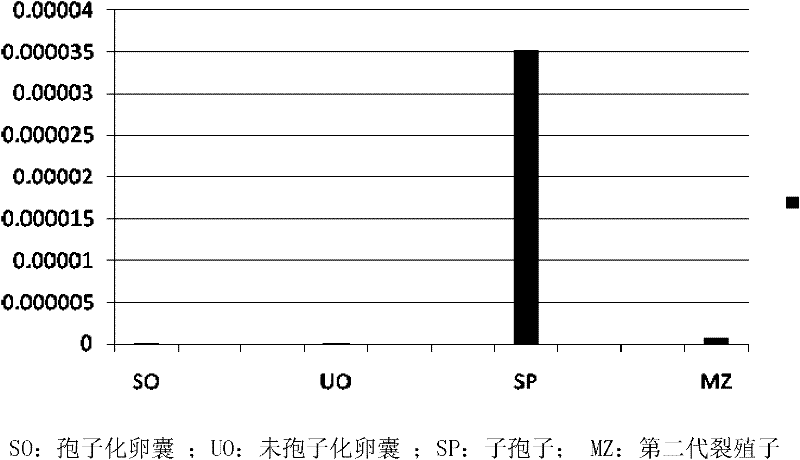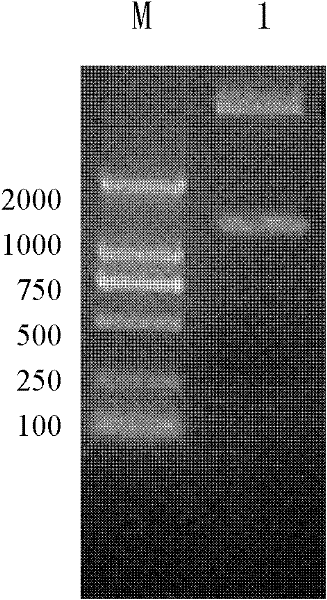Eimeria tenella calcium-dependent protein kinase gene and application thereof
A technology of Eimeria coccidiosis and genes, applied in the field of bioengineering, can solve the problems of drug resistance of coccidiosis and achieve good immunogenicity
- Summary
- Abstract
- Description
- Claims
- Application Information
AI Technical Summary
Problems solved by technology
Method used
Image
Examples
Embodiment 1
[0053] Example 1 Cloning and analysis of the full-length cDNA of the Eimeria tenella EtCDPK gene
[0054] In the early stage of the laboratory, the differentially expressed genes of sporozoites and sporulated oocysts were screened on a large scale using suppression subtractive hybridization technology and cDNA microarray technology, and a large number of differentially expressed gene ESTs were obtained. ESTs of highly expressed genes (gene clone number: ZB1-H07), Blast homology comparison analysis found that ZB1-H07 is highly homologous to Plasmodium falciparum calcium-dependent protein kinase (CDPK), which is speculated to be Eimeria tenella Calcium-dependent protein kinase, named EtCDPK.
[0055] The full-length cDNA of the EtCDPK gene was amplified by RACE technology, and the specific steps were as follows:
[0056] 1. RACE primer design
[0057] The ESTs sequence of ZB1-H07 was first compared with the E.tenella genome sequencing website ( http: / / www.Sanger.ac.uk. / pr...
Embodiment 2
[0091] Example 2 Analysis of expression differences of EtCDPK gene in different developmental stages of Eimeria tenella
[0092] The total RNA of four developmental stages of Eimeria tenella (spored oocysts, unsporulated oocysts, sporozoites, and second-generation merozoites) were extracted, and the unsporulated eggs of Eimeria tenella The first strand of cDNA of cysts, sporulated oocysts, sporozoites, and second-generation merozoites were used as templates, and real-time fluorescent quantitative PCR was used to select 18s rRNA as an internal reference to verify that the EtCDPK gene was expressed in different developmental stages of Eimeria tenella. expression in the body. Table 3 is the real-time fluorescence quantitative PCR amplification primer sequence. The results showed that the EtCDPK gene was highly expressed in the sporozoite development stage (see figure 2 ).
[0093] Table 3 real-time quantitative PCR amplification primer sequence
[0094]
Embodiment 3
[0095] Example 3 Prokaryotic expression and immunogenicity analysis of EtCDPK gene
[0096] 1. Construction of prokaryotic expression plasmids
[0097] The EtCDPK gene was connected to the prokaryotic expression vector pET28a(+), and the recombinant expression plasmid pET(28a)-EtCDPK was constructed. After the pET(28a)-EtCDPK recombinant plasmid was transformed into DH5α competent cells, the positive clones were sequenced and BamHI, Hind III double enzyme digestion identification. image 3 Shown is the enzyme digestion identification diagram of the recombinant prokaryotic expression plasmid pET(28a)-EtCDPK, in image 3 Among them, "1" represents the BamHI and HindIII double digestion product of the recombinant expression plasmid pET(28a)-EtCDPK.
[0098] The identified correct recombinant expression plasmid (pET28a-EtCDPK) was transformed into Escherichia coli BL21(DE3), and the expression was induced by 1mmol / L IPTG. The predicted molecular weight of EtCDPK is 49.3KDa. Usi...
PUM
| Property | Measurement | Unit |
|---|---|---|
| molecular weight | aaaaa | aaaaa |
| molecular weight | aaaaa | aaaaa |
| molecular weight | aaaaa | aaaaa |
Abstract
Description
Claims
Application Information
 Login to View More
Login to View More - R&D
- Intellectual Property
- Life Sciences
- Materials
- Tech Scout
- Unparalleled Data Quality
- Higher Quality Content
- 60% Fewer Hallucinations
Browse by: Latest US Patents, China's latest patents, Technical Efficacy Thesaurus, Application Domain, Technology Topic, Popular Technical Reports.
© 2025 PatSnap. All rights reserved.Legal|Privacy policy|Modern Slavery Act Transparency Statement|Sitemap|About US| Contact US: help@patsnap.com



